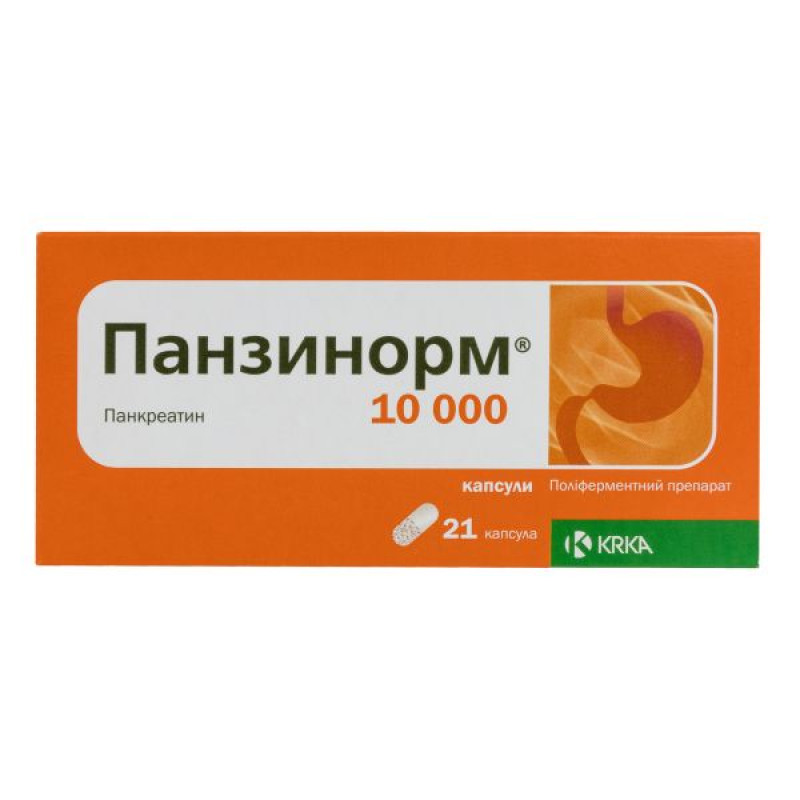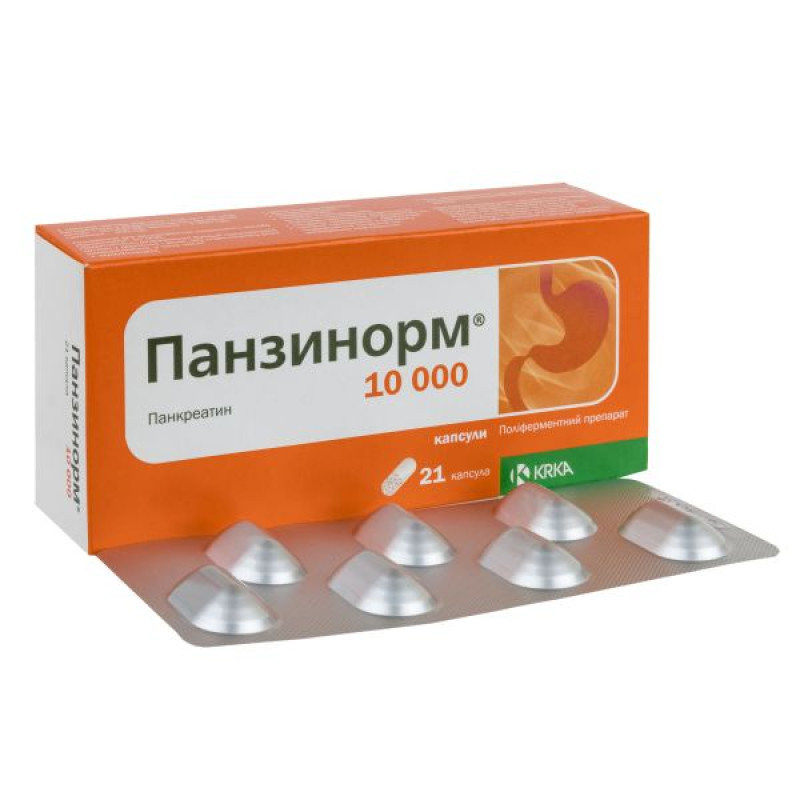Panzinorm 10,000 capsules #21

Instructions Panzinorm 10000 capsules No. 21
Composition
active ingredient: pancreatin (porcine);
1 capsule contains 106.213–136.307 mg of pancreatin with enzymatic activity of lipase – 10,000 U, amylase – 7,200 U, protease – 400 U;
excipients: methacrylate copolymer dispersion (contains methacrylic acid and ethacrylate copolymer (1:1), polysorbate 80, sodium lauryl sulfate, water), triethyl citrate, talc, simethicone emulsion 30% (contains simethicone, methylcellulose, sorbic acid, water);
hard gelatin capsule contains: gelatin, titanium dioxide (E 171).
Dosage form
Capsules.
Main physicochemical properties: white, opaque capsules filled with beige-brown granules with a characteristic odor.
Pharmacotherapeutic group
Means that improve digestion, including enzymes. Polyenzyme preparations. ATX code A09A A02.
Pharmacological properties.
Pharmacodynamics.
Panzinorm® 10,000 capsules compensate for the deficiency of pancreatic enzymes, accelerate catabolism and improve the clinical picture in case of digestive disorders. Active enzymes are released in the small intestine, where they continue to act. High lipase activity is key in the treatment of digestive disorders caused by a lack of digestive enzymes. Lipase breaks down fats into fatty acids and monoglycerides, which allows their absorption and the absorption of fat-soluble vitamins. Amylase breaks down carbohydrates into dextrins and sugars, protease acts on proteins. Panzinorm® 10,000 improves the body's nutrition by improving the absorption of various types of food, and also prevents or reduces steatorrhea and symptoms associated with digestive disorders. Panzinorm® 10,000 can reduce pain in chronic pancreatitis. This effect is attributed to the action of protease, which reduces pancreatic secretion. The mechanism of this effect is not fully understood.
Pharmacological properties
Pharmacodynamics.
Panzinorm® 10,000 capsules compensate for the deficiency of pancreatic enzymes, accelerate catabolism and improve the clinical picture in case of digestive disorders. Active enzymes are released in the small intestine, where they continue to act. High lipase activity is key in the treatment of digestive disorders caused by a lack of digestive enzymes. Lipase breaks down fats into fatty acids and monoglycerides, which allows their absorption and the absorption of fat-soluble vitamins. Amylase breaks down carbohydrates into dextrins and sugars, protease acts on proteins. Panzinorm® 10,000 improves the body's nutrition by improving the absorption of various types of food, and also prevents or reduces steatorrhea and symptoms associated with digestive disorders. Panzinorm® 10,000 can reduce pain in chronic pancreatitis. This effect is attributed to the action of protease, which reduces pancreatic secretion. The mechanism of this effect is not fully understood.
Indication
Insufficiency of exocrine pancreatic function in adults and children, caused by various diseases, including:
cystic fibrosis;
chronic pancreatitis;
pancreatectomy;
gastroectomy;
operations with the imposition of a gastrointestinal anastomosis (Billroth II gastroenterostomy);
Schwachman-Diamond syndrome;
acute pancreatitis from the moment the patient is transferred to enteral nutrition;
other diseases accompanied by exocrine pancreatic insufficiency.
Contraindication
Hypersensitivity to the active substance, pork or other ingredients of the medicinal product.
Acute pancreatitis or exacerbation of chronic pancreatitis.
Interaction with other medicinal products and other types of interactions
Pancreatic enzymes inhibit folic acid absorption. When bicarbonates and cimetidine are taken concomitantly with large doses of pancreatic enzymes, it is recommended to periodically measure serum folic acid levels and provide additional folic acid if necessary.
Pancreatic enzymes may reduce the effectiveness of acarbose and miglitol.
The acid-resistant microgranules contained in Panzinorm® 10,000 are destroyed in the duodenum. If the duodenum is too acidic, the enzymes will be released untimely. Taking H2-receptor inhibitors or proton pump inhibitors, which reduce gastric acid secretion, allows some patients to reduce the dose of Panzinorm® 10,000.
Pancreatic enzymes may reduce iron absorption, but the clinical significance of this interaction is unknown.
Application features
The drug contains active enzymes that can damage the oral mucosa, so the capsules should be swallowed whole, without chewing, and washed down with sufficient liquid.
As a precautionary measure, it is recommended to seek medical advice in case of unusual abdominal discomfort or change in abdominal symptoms to rule out the possibility of fibrosing colonopathy, especially if the patient is taking more than 10,000 IU of lipase/kg/day.
There is a theoretical risk of transmission of viral infections of pigs, including infections caused by new or unidentified viruses. The presence of porcine viruses that can infect humans cannot be completely ruled out. However, no case of transmission of infectious disease has been reported to date due to the use of porcine pancreatin preparations.
It should be used with caution in patients with renal failure and hyperuricemia.
Use during pregnancy or breastfeeding
There is no data on the safety of lipase, amylase, and protease during pregnancy.
Animal studies have not shown direct or indirect harmful effects with respect to pregnancy, embryonic development, parturition or postnatal development.
Caution should be exercised when prescribing to pregnant women. Enzymes are not absorbed from the gastrointestinal tract, but a risk cannot be excluded. The drug should be used in pregnant and lactating women only if the expected benefit to the mother outweighs the potential risk to the child.
Ability to influence reaction speed when driving vehicles or other mechanisms
No effect on the ability to drive or use machines was observed.
Method of administration and doses
The dosage of the drug is based on the individual needs of the patient and depends on the degree of digestive disorders and the composition of the food. The drug is recommended to be taken during or immediately after meals.
The capsule should be swallowed whole without chewing, washed down with sufficient liquid or taken with a light snack. For easier administration (children and the elderly), the capsule can be opened and the acid-resistant granules added to liquid food that does not require chewing, such as applesauce or a liquid with a neutral or slightly acidic environment (yogurt, grated apple). This mixture should be consumed immediately.
During treatment with Panzinorm® 10,000, it is very important to drink enough fluids, especially during periods of increased fluid loss. Fluid deficiency can worsen constipation.
Dosage for cystic fibrosis.
General recommendations for pancreatic enzyme replacement therapy:
The initial dose for children under 4 years of age is 1000 U of lipase per kilogram of body weight during each meal, for children over 4 years of age – 500 U of lipase per kilogram of body weight during each meal.
The dose should be selected individually, depending on the severity of the disease, control of steatorrhea and maintenance of adequate nutritional status.
The maintenance dose for most patients should not exceed 10,000 IU of lipase per kilogram of body weight per day or 4,000 IU of lipase per gram of fat consumed.
Dosage for other types of exocrine pancreatic insufficiency
The dose should be selected individually, depending on the degree of digestive disorders and the fat content of the food. The usual initial dose is from 10,000 to 25,000 IU of lipase during each main meal. However, it is possible that some patients require higher doses to eliminate steatorrhea and maintain proper nutritional status. According to generally accepted clinical practice, it is believed that at least 20,000 to 50,000 IU of lipase should be taken with food. The dose of lipase during main meals (breakfast, lunch or dinner) can be from 25,000 to 80,000 IU, and with additional light meals between main meals it should be half the individual dose.
Children.
Used in pediatric practice.
Overdose
There are no data on systemic intoxication in case of overdose. Overdose may cause nausea, vomiting, diarrhea, hyperuricemia and uricosuria, perianal irritation and very rarely, mainly only in patients with cystic fibrosis, fibrosing colonopathy.
In case of overdose, the drug should be discontinued, hydration of the body and symptomatic treatment are recommended.
Side effects
On the part of the immune system:
Hypersensitivity reactions, including rash, itching, redness of the skin, sneezing, urticaria, lacrimation, bronchospasm, airway obstruction, anaphylactic reactions.
From the gastrointestinal tract:
nausea, vomiting, abdominal pain, constipation or diarrhea, flatulence, change in bowel habits, skin irritation around the mouth or anus, especially after taking high doses.
In rare cases, in patients with cystic fibrosis, taking the drug in high doses (more than 10,000 U of lipase/kg body weight/day) may lead to the formation of strictures of the colon or ileocecal part of the intestine. In case of sudden or worsening abdominal pain, with flatulence, it is necessary to undergo an examination to exclude possible fibrosing colonopathy.
Impact on the results of laboratory and instrumental studies:
hyperuricemia, hyperuricosuria, folic acid deficiency.
Expiration date
3 years.
Storage conditions
Keep out of reach of children.
Packaging
7 capsules in a blister; 3 or 8 or 12 blisters in a box.
Vacation category
Without a prescription.
Producer
KRKA, dd, Novo mesto/ KRKA, dd, Novo mesto.
Location of the manufacturer and its business address.
Smarjeska cesta 6, 8501 Novo mesto, Slovenia.
There are no reviews for this product.
There are no reviews for this product, be the first to leave your review.
No questions about this product, be the first and ask your question.








